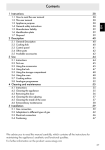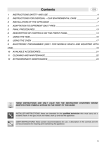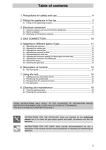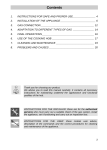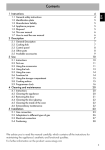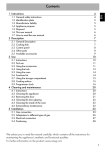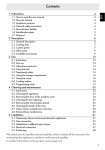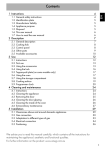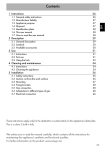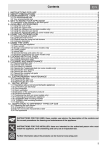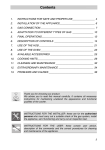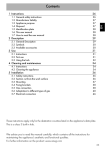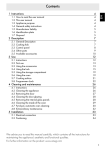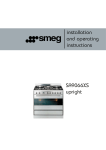Download OF901XZ User Manual
Transcript
Contents 1.1 1.2 1.3 1.4 1.5 1.6 1.7 How to read the user manual This user manual Appliance purpose General safety instructions Manufacturer liability Identification plate Disposal 2 Description 2.1 2.2 2.3 2.4 2.5 General description Cooking hob Control panel Other parts Available accessories 3 Use 3.1 3.2 3.3 3.4 3.5 3.6 3.7 Instructions Cleaning the appliance Removing the door Cleaning the door glazing Cleaning the inside of the oven Extraordinary maintenance 5 Installation 5.1 5.2 5.3 5.4 5.5 4 4 4 4 5 5 5 6 6 6 7 7 8 9 Instructions First use Using the accessories Using the hob Using the oven Cooking advice Programming clock 4 Cleaning and maintenance 4.1 4.2 4.3 4.4 4.5 4.6 4 EN 1 Instructions Clearances above and around domestic appliances Gas connection Adaptation to different types of gas Electrical connection Positioning 9 10 10 11 12 13 15 18 18 18 19 20 20 20 21 21 22 25 26 27 We advise you to read this manual carefully, which contains all the instructions for maintaining the appliance's aesthetic and functional qualities. For further information on the product: www.omegaappliance.com.au 3 Instructions 1 Instructions 1.1 How to read the user manual This user manual uses the following reading conventions: Instructions General information on this user manual, on safety and final disposal. Description Description of the appliance and its accessories. Use Information on the use of the appliance and its accessories, cooking advice. Cleaning and maintenance Information for proper cleaning and maintenance of the appliance. Installation Information for the authorised persons: installation, operation and inspection. Safety instructions Information Advice 1. Use instruction sequence. • Single use instruction. 4 1.2 This user manual This user manual is an integral part of the appliance and must therefore be kept in its entirety and in an accessible place for the whole working life of the appliance. 1.3 Appliance purpose This appliance is intended for cooking food in the home environment. Every other use is considered improper. This appliance must not be used by persons (including children) with reduced physical and mental capabilities, or lack of experience and knowledge, unless they have been given supervised or instruction concerning use of the appliance by a responsible person for their safely. 1.4 General safety instructions For your safety and to avoid damage to the appliance, always respect the general safety instructions indicated below. In general • Have qualified personnel carry out installation and assistance interventions according to the standards in force. • Read this user manual carefully before using the appliance. • Do not modify this appliance. • Do not attempt to repair the appliance yourself or without the intervention of a qualified technician. • If the power supply cable is damaged, contact the technical assistance centre immediately and they will replace it. For this appliance • Do not obstruct ventilation openings and heat dispersal slots. • Do not insert pointed metal objects (cutlery or utensils) into the slots in the • • • • • • appliance. Do not rest any weight or sit on the open door of the appliance. Take care that no objects are stuck in the doors. Do not use the appliance to heat rooms for any reason. If cooking appliances are installed in motor vehicles (for example, camper vans, caravans etc.), they must only be used when the vehicle is stationary. Not for use in marine craft, caravans or mobile homes unless each burner is fitted with a flame safeguard. This appliance is not intended to be operated by means of external timer or separate remote control system. 1.5 Manufacturer liability The manufacturer declines all responsibility for damage to persons or property caused by: • use of the appliance other than the one envisaged, • non-observance of the user manual provisions, • tampering with any part of the appliance, • use of non-original spare parts. 1.6 Identification plate The identification plate bears the technical data, serial number and brand name of the appliance. Do not remove the identification plate for any reason. 1.7 Disposal This appliance must be disposed of separately from other waste (Directives 2002/95/EC, 2002/ 96/EC, 2003/108/EC). The appliance does not contain substances in quantities sufficient to be considered hazardous to health and the environment, in accordance with current European directives. To dispose of the appliance: • Remove the doors and leave the accessories (racks and trays) in their normal working positions, so that children cannot get stuck in the oven compartment. Power voltage Danger of electrocution • Disconnect the main power supply. • Disconnect the power cable from the electrical system. • Cut the power supply cable and remove it along with the plug. • Consign the appliance to the appropriate selective collection centres for electrical and electronic equipment waste, or deliver it back to the retailer when purchasing an equivalent product, on a one for one basis. Our appliances are packed in nonpolluting and recyclable materials. • Consign the packing materials to the appropriate selective collection centres. Plastic packaging Danger of suffocation • Do not leave the packaging or any part of it unattended. • Do not let children play with the packaging plastic bags. 5 EN Instructions Description 2 Description 2.1 General description 1 Cooking hob 2 Control panel 3 Oven light 4 Seal 5 Door 6 Fan 7 Storage compartment Shelf for racks/trays support frames 2.2 Cooking hob AUX = Auxiliary SR = Semi-rapid R = Rapid UR = Ultra rapid 6 Description Temperature knob (1) This knob allows you to select the cooking temperature. Turn the knob clockwise to the required value, between the minimum and maximum settings. Indicator light (2) The indicator light comes on to indicate that the oven is heating up. It turns off as soon as it reaches the set temperature. It flashes regularly to indicate that the temperature set inside the oven is kept constant. Function knob (3) The oven's various functions are suitable for different cooking modes. After selecting the required function, set the cooking temperature using the temperature knob. Programming clock (4) Useful for displaying the current time, set programmed cooking operations and program the timer. EN 2.3 Control panel Return the knobs to the off the burners. position to turn 2.4 Other parts Oven shelves The oven features shelves for positioning trays and racks at different heights. The insertion heights are indicated from the bottom upwards (see 2.1 General description). Cooling fan The fan cools the ovens and comes into operation during cooking. The fan causes a steady outflow of air from above the door and which may continue for a brief period of time even after the appliance has been turned off. Internal light The internal light of the ovens comes on when any function is selected. Hob burner knobs (5) Useful for lighting and adjust the hob burners. Press and turn the knobs anticlockwise to the value to light the relative burners. Turn the knobs to the zone between the maximum and minimum setting to adjust the flame. 7 Description 2.5 Available accessories Handle Some models are not provided with all accessories. Rack Useful for removing hot racks and trays. Reduction pan stand Useful when using small cookware. Useful for holding cooking containers. Wok reduction pan stand Tray Useful when using a wok. Useful for collecting fat from foods placed on the rack above and for cooking pies, pizzas and baked desserts. The accessories intended to come into contact with food are made of materials that comply with the provisions of current legislation. Original and optional accessories can be requested to Authorised Assistance Centres. Use only original accessories supplied by the manufacturer. 8 Use 3.1 Instructions High temperature inside the oven during use Danger of burns • Keep the oven door closed during cooking. • Protect your hands using heat resistant gloves when moving food inside the oven. • Do not touch the heating elements inside the oven. • Do not pour water directly on very hot trays. • Young children should be supervised to ensure that they do not play with the appliance. • If you need to move food or at the end of cooking, open the door 5 cm for a few seconds, let the steam come out, then open it fully. Improper use Danger of burns • Make sure that the flame-spreader crowns are correctly positioned in their housings with their respective burner caps. • Oils and fat could catch fire if overheated. Be very careful. • During use the appliance becomes hot. Care should be taken to avoid touching heating elements inside the oven. • Accessible parts will become hot when in use. To avoid burns young children should be kept away. Improper use Risk of damage to surfaces EN 3 Use • Do not cover the bottom of the oven with aluminium or tin foil sheets. • If you wish to use greaseproof paper, place it so that it will not interfere with the hot air circulation inside the oven. • Do not place pans or trays directly on the bottom of the cooking compartment. • Do not use the open door to rest pans or trays on the internal glass pane. • Do not pour water directly on very hot trays. • Make sure that the flame-spreader crowns are correctly positioned in their housings with their respective burner caps. • The cooking vessels or griddle plates should be placed inside the perimeter of the hob. Not suitable for use with aftermarket lids or covers. • All pans must have smooth, flat bottoms. • If any liquid does boil over or spill, remove the excess from the hob. • Do not place anything, e.g. flame tamer or griddle plate between pan and pan support. • Do not remove the pan support and enclose the burner with a wok stand, only use the wok support supplied. • Do not use large pots or heavy weights which can bend the pan support or deflect flame onto the hotplate. • Locate pan centrally over the burner so that it is stable and does not overhang the appliance. 9 Use High temperature Danger of fire or explosion • Do not spray aerosols in the vicinity of this appliance while it is in operation. • Do not use or store flammable materials in the appliance storage drawer or near this appliance. • Do not use plastic kitchenware or containers when cooking food. • Do not put sealed tins or containers in the oven. • Do not leave the oven unattended during cooking operations where fats or oils could be released. • Remove from the oven compartment all trays and racks not used during cooking. • Where this appliance is installed in marine craft or in caravans, it shall not be used as a space heater. • Do not modify this appliance. 3.2 First use 1. Remove any protective film from the outside or inside of the appliance, including accessories. 2. Remove any labels (apart from the technical data plate) from the accessories and from the cooking compartments. 3. Remove all the accessories from the appliance and clean them (see 4 Cleaning and maintenance). 4. Heat the empty ovens at the maximum temperature to burn off any residues left by the manufacturing process. 10 3.3 Using the accessories Racks and trays Racks and trays have to be inserted into the side guides until they come to a complete stop. • The mechanical safety locks that prevent the rack from being taken out accidentally have to face downwards and towards the oven back. Gently insert racks and trays into the oven until they come to a stop. Clean the trays before using them for the first time to remove any residues left by the manufacturing process. Tray rack 3.4 Using the hob The tray has to be inserted into the rack. In this way fat can be collected separately from the food which is being cooked. All the appliance's control and monitoring devices are located together on the front panel. The burner controlled by each knob is shown next to the knob. The appliance is equipped with an electronic ignition device. Simply press the knob and turn it anticlockwise to the maximum flame symbol, until the burner lights. If the burner does not light in the first 15 seconds, turn the knob to and wait 60 seconds before trying again. After lighting, keep the knob pressed down for a few seconds to allow the thermocouple to heat up. The burner may go out when the knob is released: in this case, the thermocouple has not heated up sufficiently. Wait a few moments and repeat the operation. Keep the knob pressed in longer. Reduction pan stands The reduction pan stands have to be placed on the hob grids. Make sure they are properly placed. In case of an accidental switching off, a safety device will be tripped, cutting off the gas supply, even if the gas tap is open. Return the knob to and wait at least 60 seconds before lighting it again. 11 EN Use Use Correct position for flame-spreader crowns and burner caps Before lighting the hob burners, make sure that the flame-spreader crowns are correctly positioned in their housings with their respective burner caps. Make sure that the holes in the flame-spreader crowns are aligned with the igniters and thermocouples (A). 3.5 Using the oven Switching on the oven To switch the oven on: 1. Select the cooking function using the function knob. 2. Select the temperature using the temperature knob. Functions list Bottom The heat coming just from the bottom allows you to complete the cooking of foods that require a higher bottom temperature, without affecting their browning. Perfect for cakes, pies, tarts and pizzas. Practical tips for using the hob For better burner efficiency and to minimise gas consumption, use pans with lids and of suitable size for the burner, so that flames do not reach up the sides of the pan. Once the contents come to the boil, turn down the flame far enough to ensure that the liquid does not boil over. Cookware diameters: • Auxiliary: 12 - 14 cm. • Semi-rapid: 16 - 24 cm. • Rapid: 18 - 26 cm. • Ultra-rapid: 18 - 26 cm. 12 Static As the heat comes from above and below at the same time, this system is particularly suitable for certain types of food. Traditional cooking, also known as static cooking, is suitable for cooking just one dish at a time. Perfect for all types of roasts, bread and cakes and in any case particularly suitable for fatty meats such as goose and duck. Grill The heat coming from the grill element gives perfect grilling results above all for thin and medium thickness meat and in combination with the rotisserie (where present) gives the food an even browning at the end of cooking. Perfect for sausages, ribs and bacon. This function enables large quantities of food, particularly meat, to be grilled evenly. Fan-assisted grill The air produced by the fan softens the strong heatwave generated by the grill, grilling perfectly even very thick foods. Perfect for large cuts of meat (e.g. shin of pork). Fan-assisted bottom The combination of the fan with just the lower heating element allows cooking to be completed more rapidly. This system is recommended for sterilising or for finishing off the cooking of foods which are already well-cooked on the surface, but not inside, which therefore need a little more heat. Perfect for any type of food. In pyrolytic models, the special defrosting and proving functions are brought together under the same function. Fan-assisted circular The combination of the fan and the circular element (incorporated in the rear of the oven) allows you to cook different foods on several levels, as long as they need the same temperatures and same type of cooking. Hot air circulation ensures instant and uniform distribution of heat. It will be possible, for instance, to cook fish, vegetables and biscuits simultaneously (on different levels) without mixing odours and flavours. 3.6 Cooking advice General advice • Use a fan-assisted function to achieve uniform cooking at several levels. • It is not possible to shorten cooking times by increasing the temperature (the food could be overcooked on the outside and undercooked on the inside). • Using more ovens at the same time might affect the final cooking results. Advice for cooking meat • Cooking times vary according to the thickness and quality of the food and to consumer taste. • Use a meat thermometer when roasting meat, or simply press on the roast with a spoon. If it is hard, it is ready; if not, it needs another few minutes cooking. 13 EN Use Use Advice for cooking with the Grill and the Fan-assisted grill • Meat can be grilled even when it is put into the cold oven or into the preheated oven if you wish to change the effect of the cooking. • With the Fan-assisted grill function, we recommend that you preheat the oven before grilling. • We recommend placing the food at the centre of the rack. • With the Grill function, we recommend that you turn the temperature knob to the maximum value near the symbol to optimise cooking. • Foods should be seasoned before cooking. Foods should also be coated with oil or melted butter before cooking. • Use the oven tray on the first bottom shelf to collect fluids produced by grilling. • Grilling processes should never last more than 60 minutes using multifunction ovens, 30 minutes inside the auxiliary oven. Advice for cooking desserts and biscuits • Use preferably dark metal moulds: they help to absorb the heat better. • Temperature and cooking time depend on the quality and consistency of the dough. • To check whether the dessert is cooked right through: at the end of the cooking time, put a toothpick into the highest point of the dessert. If the dough does not stick to the toothpick, the dessert is cooked. 14 • If the dessert collapses when it comes out of the oven, on the next occasion reduce the set temperature by about 10°C, selecting a longer cooking time if necessary. • While cooking desserts or vegetables, excessive condensation may form on the glass. In order to avoid this, open the door very carefully a couple of times while cooking. Advice for defrosting and proving • Place frozen foods without their packaging in a lidless container on the first shelf of the oven. • Avoid overlapping the food. • To defrost meat, use the rack placed on the second level and a tray on the first level. In this way, the liquid from the defrosting food drains away from the food. • The most delicate parts can be covered with aluminium foil. • For successful proving, a container of water should be placed in the bottom of the oven. To save energy • Stop cooking a few minutes before the time normally used. Cooking will continue for the remaining minutes with the heat which has accumulated inside the oven. • Reduce any opening of the door to a minimum to avoid heat dispersal. • Keep the inside of the appliance clean at all times. 3.7 Programming clock Timed cooking Timed cooking is the function which allows a cooking operation to be started and then ended after a specific length of time set by the user. 1. After selecting a cooking function and temperature, press key . The display will shows the digits and the symbol displayed between the hours and the minutes. 1 Timer key 2 Cooking time key 3 End of cooking key 4 Value decrease key 5 Value increase key Setting the time On the first use, or after a power failure, the digits will be flashing on the appliance's display. 1. Press the and keys at the same time. The dot between the hours and the minutes flashes. 2. The time can be set using or . Hold down the key to increase or decrease rapidly. 3. Press the key or wait 5 seconds. The dot between the hours and the minutes stops flashing. 4. The symbol on the display indicates that the appliance is ready to start cooking. 2. Use the key or to set the required minutes. 3. Wait approx. 5 seconds without pressing any key in order for the function to activate. The current time and the symbols and will appear on the display. 4. At the end of cooking the heating elements will be deactivated. On the display, symbol turns off, symbol flashes and the buzzer sounds. 5. To turn off the buzzer just press any key of the programmer clock. 6. Press keys and at the same time to reset the programmer clock. It is not possible to set a cooking time of more than 10 hours. After the setting, to display the cooking time left press the key. To reset the set program, press keys and at the same time and switch off the oven manually. 15 EN Use Use Programmed cooking Programmed cooking is the function which allows a cooking operation to be started at a set time and then ended after a specific length of time set by the user. 1. Set the cooking time as described in the previous point “Timed cooking”. 2. Press key. The sum of the current time plus the pre-set cooking duration will appear on the display. 3. Use the or key to set the required minutes. 4. Wait approx. 5 seconds without pressing any key in order for the function to activate. The current time and the symbols and will appear on the display. 5. At the end of cooking the heating elements will be deactivated. On the display, symbol turns off, symbol flashes and the buzzer sounds. 6. To turn off the buzzer just press any key of the programmer clock. 7. Press keys and at the same time to reset the programmer clock. After the setting, to display the cooking time left press the key. To display the end of cooking time, press the key. 16 Timer The timer does not stop the cooking but rather informs the user when the set time has run out. The timer can be activated at any time. 1. Press key. The display will shows the digits and the indicator light flashing between the hours and the minutes. 2. Use the or key to set the required minutes. 3. Wait approx. 5 seconds without pressing any key to finish setting the timer. The current time and the symbols and appear on the display. It is not possible to set a cooking time of more than 24 hours. After the timer has been programmed, the display will go back to showing the current time; to display the remaining time, press . Adjusting the buzzer volume The buzzer volume can be set to 3 different levels. When the buzzer is in operation, press to change the setting. Deleting the set data Press keys and at the same time to reset the programs set. Then switch off the oven manually if cooking is in progress. Use Food Lasagne Oven-baked pasta Roast veal Pork loin Pork shoulder Roast rabbit Turkey breast Roast pork neck Roast chicken 3 2.5 Static Static Runner position from the bottom 1 or 2 1 or 2 1 1 1 1 1 1 1 Circular Circular Fan-assisted static Circular Fan-assisted static Fan-assisted static Fan-assisted static 2 2 2 2 2 2 2 Weight (Kg) Pork chops Pork fillet Beef fillet Liver slices Sausages Meatballs Function EN Cooking information table Temperature Time (°C) (minutes) 220 - 230 220 - 230 40 - 50 40 180 - 190 180 - 190 180 - 190 180 - 190 180 - 190 180 - 190 190 - 200 70 - 80 70 - 80 90 - 100 70 - 80 110 - 120 190 - 210 60 - 70 1st surface 2nd surface 7-9 9 - 11 9 - 11 2-3 7-9 7-9 5-7 5-9 9 - 11 2-3 5-6 5-6 Fan-assisted grill Grill Grill Fan-assisted grill Fan-assisted grill Grill 4 3 3 4 3 3 250 250 250 250 250 250 Circular 2 160 - 170 35 - 40 Pizza Bread Focaccia Fan-assisted static Circular Fan-assisted static 1 1 1 250 190 - 200 180 - 190 6 - 10 25 - 30 15 - 20 Ring cake Fruit tart Short pastry Jam tarts Paradise cake Cream puffs Light sponge cake Rice pudding Brioches Short pastry biscuits Circular Circular Circular Fan-assisted static Circular/Static Fan-assisted static Circular Circular/Static Circular Fan-assisted static 2 2 1 or 2 1 or 2 2 2 2 2 2 1-3 160 160 160 - 170 160 - 170 170 150 - 160 150 - 160 160 - 170 160 160 - 170 55 - 60 30 - 35 20 - 25 40 - 50 50 - 60 40 - 50 45 - 50 50 - 60 25 - 30 16 - 20 Salmon trout 0.7 The times indicated in the table do not include preheating times and are provided as a guide only. 17 Cleaning and maintenance 4 Cleaning and maintenance 4.1 Instructions Improper use Risk of damage to surfaces • Do not use a steam cleaner to clean the cooker. • Do not use cleaning products containing chlorine, ammonia or bleach on steel parts or parts with metallic finishes on the surface (e.g. anodizing, nickel- or chromium-plating). • Do not use abrasive or corrosive detergents on glass parts (e.g. powder products, stain removers and metallic sponges). • Do not use harsh abrasive cleaners or sharp metal scrapers to clean the oven glass door since they can scratch the surface, which may result in shattering of the glass. • Do not use rough or abrasive materials or sharp metal scrapers. • Do not wash the removable components such as the hob pan stands, flame-spreader crowns and burner caps in a dishwasher. 4.2 Cleaning the appliance To keep the oven surfaces in good condition, they should be cleaned regularly after use. Let them cool first. Ordinary daily cleaning Always use only specific products that do not contain abrasives or chlorine-based acids. 18 Pour the product onto a damp cloth and wipe the surface, rinse thoroughly and dry with a soft cloth or a microfibre cloth. Food stains or residues Do not use metallic sponges or sharp scrapers as they will damage the surfaces. Use ordinary non-abrasive products with the aid of wooden or plastic utensils if necessary. Rinse thoroughly and dry with a soft cloth or a microfibre cloth. Do not allow residues of sugary foods (such as jam) to set inside the oven. If left to set for too long, they might damage the enamel lining of the oven. Cooking hob pan stands Remove the pan stands and clean them with lukewarm water and non-abrasive detergent. Make sure to remove any encrustations. Dry them thoroughly and return them to the hob. Continuous contact between the pan stands and the flame can cause modifications to the enamel over time in those parts exposed to heat. This is a completely natural phenomenon which has no effect on the operation of this component. Flame-spreader crowns and burner caps For easier cleaning, the flame-spreader crowns and the burner caps can be removed. Wash them in hot water and nonabrasive detergent. Carefully remove any encrustation, then wait until they are perfectly dry. Refit the flame-spreader crowns making sure that they are correctly positioned in their housings with their respective burner caps. Igniters and thermocouples For correct operation the igniters and thermocouples must always be perfectly clean. Check them frequently and clean them with a damp cloth if necessary. Remove any dry residues with a wooden toothpick or a needle. 2. Grasp the door on both sides with both hands, lift it forming an angle of around 30° and remove it. 3. To reassemble the door, put the hinges in the relevant slots in the oven, making sure that grooved sections are resting completely in the slots. Lower the door and disengage the lock levers. 4.3 Removing the door For easier cleaning, the door can be removed and placed on a canvas. To remove the door proceed as follows: 1. Open the door completely and lift levers near the two hinges. 19 EN Cleaning and maintenance Cleaning and maintenance 4.4 Cleaning the door glazing The glass in the door should always be kept thoroughly clean. Use absorbent kitchen roll. In case of stubborn dirt, wash with a damp sponge and an ordinary detergent. We recommend the use of cleaning products distributed by the manufacturer. 4.5 Cleaning the inside of the oven For the best oven upkeep, clean it regularly after having allowed it to cool. Take out all removable parts. 4.6 Extraordinary maintenance Live parts Danger of electrocution • Ensure the appliance is switched off before replacing the lamp to avoid the possibility of electric shock. Replacing the internal light bulb Remove the bulb protector A by turning it anticlockwise and replace bulb B with a similar one. Re-fit bulb protector A. Removing the seal Clean the oven racks with warm water and non-abrasive detergent. Carefully rinse and dry the damp parts. To permit thorough cleaning of the oven, the door seal can be removed. There are hooks on all four sides to attach it to the edge of the oven. Pull the edges of the seal outwards to detach the hooks. The oven should be operated at the maximum temperature for about 15-20 minutes after the use of specific products, to burn off the residues left inside the oven. For easier cleaning, remove the door. 20 To keep the seals clean, use a non-abrasive sponge and lukewarm water. Seals should be soft and elastic. Installation EN 5 Installation 5.1 Clearances above and around domestic appliances This appliance must be installed by an authorised person in accordance with this instruction manual, AS/NZS 5601.1 – Gas installations (installation and pipe sizing), local gas fitting regulations, local electrical regulations, Building Code of Australia and any other government authority. Requirements 1. Overhead clearances – (Measurement A) Range hoods and exhaust fans shall be installed in accordance with the manufacturer’s instructions. However, in no case shall the clearance between the highest part of the hob of the cooking appliance and a range hood be less than 600 mm or, for an overhead exhaust fan, 750 mm. Any other downward facing combustible surface less than 600 mm above the highest part of the hob shall be protected for the full width and depth of the cooking surface area in accordance with Clause 5.12.1.2. However, in no case shall this clearance to any surface be less than 450 mm. 2. Side clearances – (Measurements B & C) Where B, measured from the periphery of the nearest burner to any vertical combustible surface, is less than 200 mm, the surface shall be protected in accordance with Clause 5.12.1.2 to a height C of not less than 150 mm above the hob for the full dimension (width or depth) of the cooking surface area. Where the cooking appliance is fitted with a ‘splashback’, protection of the rear wall is not required. 21 Installation 3. Additional requirements for Freestanding and Elevated Cooking Appliaces – (Measurements D & E) Where D, the distance from the periphery of the nearest burner to a horizontal combustible surface is less than 200 mm, then E shall be 10 mm or more, or the horizontal surface shall be above the trivet. See insets above. Notes 1. Requirement 3 does not apply to a freestanding or elevated cooking appliance which is designed to prevent flames or the cooking vessels from extending beyond the periphery of the appliance. 2. The ‘cooking surface area’ is defined as that part of the appliance where cooking normally takes place and does not include those parts of the appliance containing control knobs. 3. For definition of hob, see Clause 1.4.64. 4. For definition of trivet, see Clause 1.4.109. 5. Consideration is to be given to window treatments when located near cooking appliances. See Clause 5.3.4. The appliance connection point shall be accessible with the appliance installed. 22 5.2 Gas connection Gas leak Danger of explosion • After carrying out any operation, check that the tightening torque of gas connections is between 10 Nm and 15 Nm. • If required, use a pressure regulator that complies with current regulations. • At the end of the installation, check for any leaks with a soapy solution, never with a flame. • Installation with flexible hose must be carried out so that the length of the piping does not exceed 1,2 metres when fully extended; make sure that the hoses do not come into contact with moving parts and that they are not crushed in any way. • The hoses should not come into contact with moving parts and should not be crushed in any way. General informations This appliance is suitable for installation with Natural Gas or ULPG (propane/butane). Refer to “Burner and nozzle characteristics table” paragraph for the relevant burner pressure and appropriate injector sizes. When the appliance is to be connected to Natural Gas then the pressure regulator supplied must be fitted to the gas inlet. A test point (for checking the gas pressure) is supplied either with the regulator or as a separate fitting in the case of ULPG (propane) appliances. Connection of the appliance to the gas supply must be in accordance with the requirements of AS5601. A ½” BSP connector at the inlet is recommended and the gas supply line to the appliance must be of adequate length to allow sufficient withdrawal of appliance for service or disconnection and be: 1. annealed copper pipe or; 2. flexible hose according to AS/NZ1869 & be at least Class “B”, 10 mm diameter. To check the operating pressure of the appliance it is recommended at least 2 large size burners are used. Ensure appliance is secured to wall when installation is completed. N.G. The regulator supplied must be fitted to the ½ BSP thread at the rear of the appliance. An approved manual shut-off valve must be installed. The N.G. regulator must be checked and adjusted to 1.0kPa after installation. U.L.P.G. Can be connected to the inlet fitting directly. The pressure must be checked to ensure it is operating at 2.75kPa. A separate test point fitting must be installed between the piping & the appliance for the pressure to be checked to ensure it is operating at 2.75kPa. The appliance must be installed with provision to allow the gas to be turned off and disconnected for servicing and removal of the appliance as required from the gas supply. Before the appliance is operated make certain all relevant parts are placed in the correct position. On completion of the installation, the installer MUST check for gas leaks and test each burner individually for the correct flame. Once all burners have been tested individually, turn all burners on together. Warranty service calls do not cover these adjustments! 23 EN Installation Installation Connection to liquid gas Use a pressure regulator and make the connection on the gas cylinder following the guidelines set out in the regulations in force. Make sure that the supply pressure complies with the values indicated in the paragraph “ Burner and nozzle characteristics table”. Room ventilation The room containing the appliance should have a permanent air supply in accordance with the standards in force. The room where the appliance is installed must have enough air flow needed for the regular combustion of gas and the necessary air change in the room itself. The hob shall be installed in rooms with natural ventilation, as required by Standards regulations AS/NZS5601. 1 Extraction using a hood. 2 Extraction without a hood. A Single natural draught chimney. B Single chimney with extractor fan. C Directly outdoors with wall- or windowmounted extractor fan. D Directly outdoors through wall. Combustion gas discharge Air Combustion gases may be discharged by means of hoods connected to a flue with reliable natural draught, or a fan extraction system. An effective extraction system requires careful design by an authorised specialist, and must comply with the regulation distances and positions. After installation, the engineer must issue a certificate of compliance. Combustion products 24 Extractor fan 5.3 Adaptation to different types of gas Turn the knob rapidly from the maximum to the minimum setting: the flame should not go out. Repeat the operation on all gas taps. The appliance is pre-set for natural gas at a pressure of 1.0 kPa. In case of operation with other types of gas, the burner nozzles must be changed and the minimum flame adjusted on the gas taps. Replacing nozzles 1. Remove the pan stands, burner caps and flame-spreader crowns to access the burner casings. 2. Replace the nozzles using a 7 mm socket wrench according to the gas to use (see “Burner and nozzle characteristics table”). Adjusting the minimum setting for LPG Tighten the screw located at the side of the tap rod clockwise all the way. Following adjustment to a gas other than the one originally set in the factory, replace the gas setting label fixed to the appliance with the one corresponding to the new gas. The label is inserted inside the nozzle pack (where present). Lubrication of gas taps 3. Replace the burners in the correct position. Adjusting the minimum setting for natural or city gas Light the burner and turn it to the minimum position. Extract the gas tap knob and turn the adjustment screw next to the tap rod (depending on the model) until the correct minimum flame is achieved. Refit the knob and verify that the burner flame is stable. Over time the gas taps may become difficult to turn and get blocked. Clean them internally and replace the lubrication grease. The greasing of the gas taps should be performed by a specialised technician. 25 EN Installation Installation Burner and nozzle characteristics table 1 ULPG 2.75 kPa AUX SR R UR Nominal gas consumption (MJ/h) Injector (1/100 mm) 3.9 54 6.3 68 10.8 88 15.0 105 2 NG 1.0 kPA AUX SR R UR Nominal gas consumption (MJ/h) Injector (1/100 mm) 3.9 90 7.5 120 12 155 15.0 175 5.4 Electrical connection Power voltage Danger of electrocution • Have the electrical connection performed by authorised technical personnel. • Use personal protective equipment. • The appliance must be connected to earth in compliance with electrical system safety standards. • Disconnect the main power supply. • Do not pull the cable to remove the plug. • Use cables withstanding a temperature of at least 90°C. • The tightening torque of the screws of the terminal supply wires must be 1.5 - 2 Nm. General information Check the grid characteristics against the data indicated on the plate. The identification plate bearing the technical data, serial number and brand name is visibly positioned on the appliance. A copy of the identification plate is included in the booklet. It should be applied to an adjacent surface or this instruction manual. Do not remove this plate for any reason. 26 Perform the ground connection using a wire that is 20 mm longer than the other wires. The appliance can work in the following modes: • 220-240 V 1N~ use a 3 x 2,5 mm² three-core cable. The values indicated above refer to the cross-section of the internal conductor. The aforementioned power cables are sized taking into account the coincidence factor (in compliance with standard EN 60335-2-6). Fixed connection Fit the power line with an omnipolar circuit breaker in compliance with installation regulations. The circuit breaker should be located near the appliance and in an easily reachable position. Installation Make sure that the plug and socket are of the same type. Avoid use of adapters and shunts as these could cause overheating and a risk of burns. Overall dimensions Location of gas and electrical connection points. 5.5 Positioning EN Connection with plug and socket Heavy appliance Danger of crush injuries • Place the appliance into the piece of furniture with the aid of a second person. Pressure on the open door Risk of damages to the appliance • Never use the oven door to lever the appliance into place when fitting. • Avoid exerting too much pressure on the oven door when open. Heat production during appliance operation Risk of fire A B C D 46 mm 660 mm 124 mm 41 mm • Veneers, adhesives or plastic coatings on adjacent furniture should be temperature-resistant (no less than 90°C). General information This appliance may be installed next to walls, one of which must be higher than the worktop, at a minimum distance of 50 mm from the side of the appliance, as shown in figures A and C relative to the installation classes. Any wall units positioned above the worktop must be at a minimum distance of at least 750 mm. If a hood is installed above the hob, refer to the hood instruction manual to ensure the correct clearance is left. 27 Installation Depending on the type of installation, this appliance belongs to classes: C - Class 2 subclass 1 A - Class 1 (Free-standing appliance) (Built-in appliance) The appliance must be installed by a qualified technician and according to the regulations in force. If the appliance is installed on a raised platform, secure it using suitable fastening systems. DO NOT MODIFY THIS APPLIANCE. Assembling the skirt The skirt provided is an integral part of the product; it must be fastened to the appliance prior to installation. B - Class 2 subclass 1 (Built-in appliance) 28 The skirt must always be positioned and secured correctly on the appliance. 1. Unscrew the 2 nuts (B) on the back of the worktop. 2. Position the skirt above the worktop, taking care to align the pins (C ) with the holes (D). 3. Secure the skirt to the worktop by tightening screws (A). The appliance must be properly levelled to ensure better stability. Screw or unscrew the bottom part of the foot until the appliance is stable and level on the floor. Wall mounting brackets The fastening system provided must be installed to ensure the appliance is stable. If installed correctly, this system prevents the appliance tipping over. Positioning and levelling the appliance 1. Use the adjustable feet to level the appliance at the required height. Heavy appliance Risk of damages to the appliance • Insert the front feet first and then the rear ones. After making the electrical and/or gas connections, level the appliance on the floor by means of its four adjustable feet. 2. Measure the distance from the index of the opening to the floor. 29 EN Installation Installation Wall fixing 3. Use the same height on the wall to drill the holes for fastening the brackets. The distance between the centres of the holes is given in the diagram above. 1. Attach the chain to the cooker 2. Stretch out the chain attached to the cooker horizontally so that the other end touches the wall. 3. Mark the wall in the position where the hole is to be drilled. 4. Drill the hole, insert a wall plug and attach the chain. 5. Once the chain is in position, push the cooker against the wall and reduce the amount of chain links to keep the chain tight to prevent any excess movement. 4. Before tightening the brackets fully to the wall, check that the index on the brackets is at the same height as the index on the back of the appliance. Position the appliance, taking care that the brackets are correctly inserted. The chain length must be as short as practicable to avoid appliance tilting forward and also diagonal to avoid appliance moving sideways. 30




























